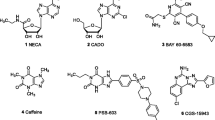Abstract
Four adenosine receptor subtypes of the family of G protein-coupled receptors, designated A1, A2A, A2B and A3 are currently known. In this study all human subtypes were stably transfected into Chinese hamster ovary (CHO) cells in order to be able to study their pharmacological profile in an identical cellular background utilizing radioligand binding studies (A1, A2A, A3) or adenylyl cyclase activity assays (A2B). The A1 subtype showed the typical pharmacological profile with 2-chloro-N6-cyclopentyladenosine (CCPA) as the agonist with the highest affinity and a marked stereoselectivity for the N6-phenylisopropyladenosine (PIA) diastereomers. In competition with antagonist radioligand biphasic curves were observed for agonists. In the presence of GTP all receptors were converted to a single low affinity state indicating functional coupling to endogenous G proteins. For A2A adenosine receptors CGS 21680 (2-[p-(2-carboxyethyl)phenylethylamino]-5′-N-ethylcarboxamidoadenosine) and N-ethylcarboxamidoadenosine (NECA) were found to be the most potent agonists followed by R- and S-PIA with minor stereoselectivity. The relative potencies of agonists for the A2B adenosine receptor could only be tested by measurement of receptor-stimulated adenylyl cyclase activity. NECA was the most potent agonist with an EC50-value of 2.3 μM whereas all other compounds tested were active at concentrations in the high micromolar range. Inhibition of NECA-stimulated adenylyl cyclase identified xanthine amino congener (XAC; 8-[4-[[[[(2-aminoethyl)amino]carbonyl]methyl]oxy]phenyl]-1,3-dipropylxanthine) as the most potent antagonist at this receptor subtype. The A3 receptor was characterized utilizing the nonselective agonist [3H]NECA. The N6-benzyl substituted derivatives of adenosine-5′-N-methyluronamide (MECA) turned out to be the most potent agonists. The notion of xanthine-insensitivity of the A3 receptor should be dropped at least for the human receptor as xanthines with submicromolar affinity were found. Overall, the pharmacological characteristics of the human receptors are similar to other species with some species-specific characteristics.
In this study we present for the first time the comparative pharmacology of all known human adenosine receptor subtypes. The CHO cells with stably transfected adenosine receptors provide an identical cellular background for such a pharmacological characterization. These cells are valuable systems for further characterization of specific receptor subtypes and for the development of new ligands.
Similar content being viewed by others
Author information
Authors and Affiliations
Additional information
Received: 14 July 1997 / Accepted: 26 September 1997
Rights and permissions
About this article
Cite this article
Klotz, KN., Hessling, J., Hegler, J. et al. Comparative pharmacology of human adenosine receptor subtypes – characterization of stably transfected receptors in CHO cells. Naunyn-Schmiedeberg's Arch Pharmacol 357, 1–9 (1997). https://doi.org/10.1007/PL00005131
Issue Date:
DOI: https://doi.org/10.1007/PL00005131




